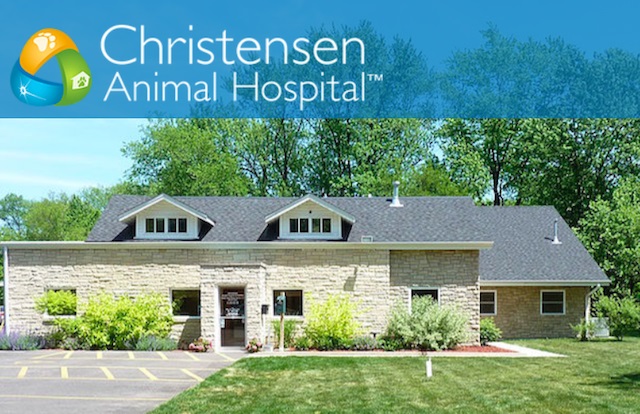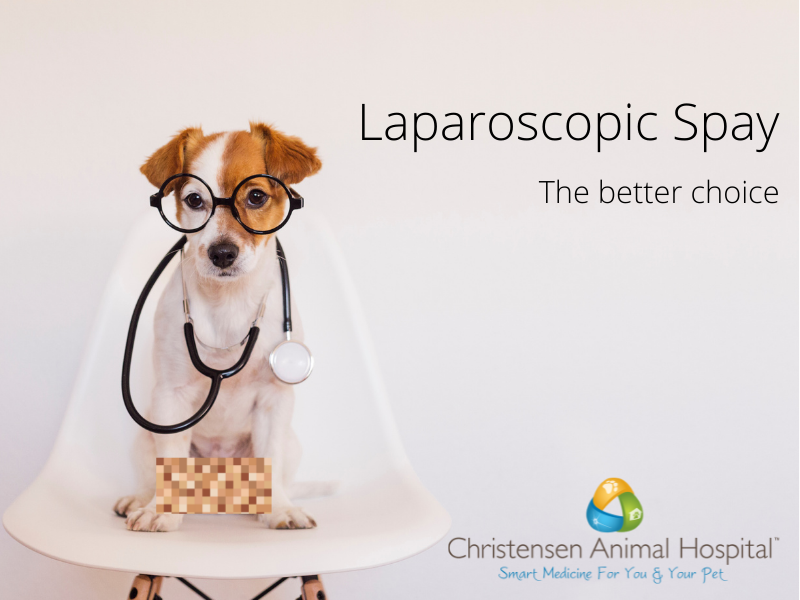A laparoscopic approach is a great option for less pain, faster healing, and little or no bleeding. This is the remarkable minimally invasive procedure we use to sterilize female cats and dogs to guard against unwanted pregnancy and complications such as pyometra which is an infection of the uterus, most often resulting in death if not surgically removed immediately. Our laparoscopic spay procedure uses the very same equipment as is used for human laparoscopic procedures and requires the same training.
The laparoscopic spay procedure begins like any other surgical procedure. Once our patient is under anesthesia, we begin with two incisions. Each incision is about one-quarter to one-half-inch in length. The length of incisions will depend on the size of the pet. The larger the animal, the larger the incision. Once the incisions are made, a device called a trocar (looks like a rigid straw or tube) is inserted and used as a port for a tiny camera to view inside the pet’s abdomen. This port and camera will allow the doctor to view everything they’ll need to in order to quickly and safely perform the laparoscopic spay.
Once the doctor has secured the ports for the camera and cauterizing tool called a LigaSure, they will begin the actual removal of ovaries. The LigaSure is an electrothermal vessel-sealing system that provides hemostasis by creating a seal using pressure and electrothermal energy to change the structure of the vessel walls and surrounding tissues (Covidien, 2017). In other words, the LigaSure is a device that seals blood vessels while it is cutting tissue so there is little to no bleeding. Once a vessel has been sealed in this manner, there is very little chance of rupture. Whereas with a traditional spay, vessels are cut with stainless steel tools and sutured to create the seal, those sutures can slip and/or loosen.

After the ovaries have been completely separated from the supporting tissue, they are pulled through the same trocars (ports) that were created at the start of the spay procedure and the same ones used by the camera and LigaSure, ensuring no additional incisions need to be made. Ovaries are removed and discarded. Sutures are used to close the small incisions made at the start of the procedure and pets are then placed in a recovery ward and monitored by a dedicated recovery technician until they wake up and are ready to return home.
Laparoscopic spay is widely considered the safest and least painful method of achieving sterilization. Sutures used to close the small incisions are absorbable so they will not need to return for suture removal. The only two aftercare advisements for our lap spay patients is that they wear an e-collar or bodysuit (“suiticals” can be purchased at popular pet stores and online) for 10 to 14 days to discourage the pet from investigating their incisions and licking which could prolong healing or cause the pet to return to be sutured again. Also, there should be no bathing during the initial 10 to 14-day healing window. Otherwise, there are no activity restrictions.
At Christensen Animal Hospital, the laparoscopic spay is our exclusive spay option and has been for over 6 years. Our doctors are strong advocates of laparoscopic spay because of its clear benefits. Pain reduction at about 65%, less trauma to tissue, less bleeding (if any), less healing time due to tiny incisions, and a much quicker return to normal activity. Though laparoscopic spay procedures are understood to be the safer option, our surgeons take care to point out that with any surgical event, there are risks and there may be complications. Very few complications have been noted, however, there is always potential. Should a complication arise, potentially compromising the safety of our patient, our doctors may opt to change course and continue the procedure by performing a traditional spay, if that option appears to be the best course.
Due to the laparoscopic spay being an elevated procedure, it does require much more expensive equipment and advanced training to perform successfully. Laparoscopic spay cost tends to be a bit higher due to the elevated cost of performing such procedures. When we compare the benefits between lap spay and traditional, the extra cost is minimal. You may contact us any time to schedule a consultation with our doctors regarding this procedure and so many others. We perform many specialty-level procedures at a more reasonable cost than many of our local specialty hospitals. We are a veterinary practice that has a singular goal of meeting and exceeding our client expectations by offering the highest quality care, supporting our pet families with excellent client service, and by advocating for pets and pet families in every way.
Our recent client experiences say it best:
“My puppy had a laparoscopic spay surgery. The same day home and eating :), 2 tiny incisions that healed completely in 5 days. Happy and would highly recommend!”
Elena, Christensen Animal Hospital Client
“The minimally invasive laparoscopic technique ensures our dog was literally back to normal the following day… two tiny holes (no big incision, no visible stitches, no cone – just a cute surgical suit recommended by the doctor). By contrast, my sister-in-law took 3 days off from work (+weekend) had to carry her puppy in her arms to relieve her discomfort after a traditional spay. THANK YOU! I’m grateful I discovered your amazing practice.“
Marina, Christensen Animal Hospital Client


